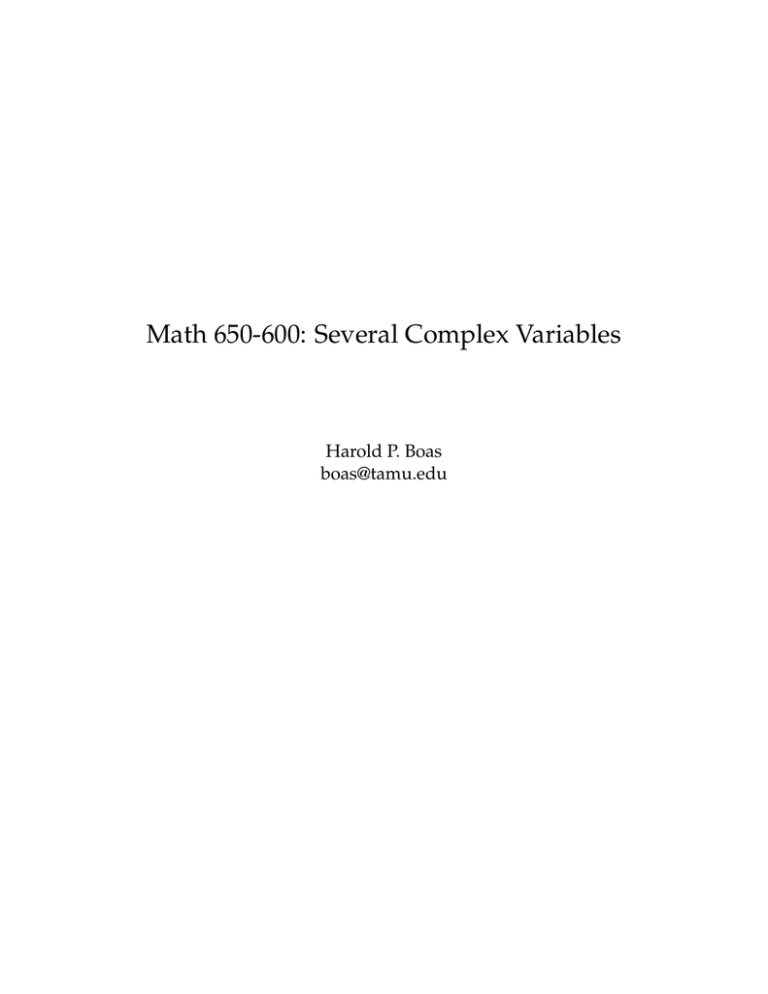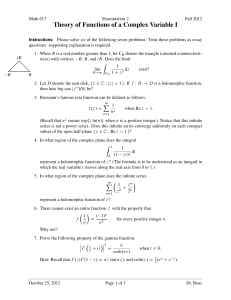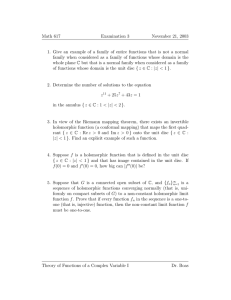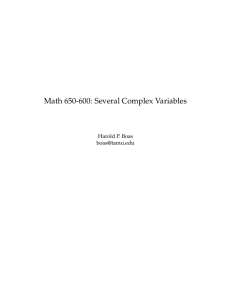Math 650-600: Several Complex Variables Harold P. Boas
advertisement

Math 650-600: Several Complex Variables Harold P. Boas boas@tamu.edu Announcement Math Club Meeting Monday, January 31 at 6:30 pm Blocker 627 Robert S. Smith (Miami University) Boolean Algebra and Switching Circuits Math 650-600 January 27, 2005 — slide #2 Announcement Next week I will be traveling to Washington. Our class will meet on February 1 (Tuesday) but will not meet on February 3 (Thursday). Math 650-600 January 27, 2005 — slide #3 Reminders from last time Convergence domains for power series are logarithmically convex complete Reinhardt (multicircular) domains. A function with continuous (real) partial derivatives is holomorphic if (a) it is represented locally by an absolutely convergent power series, or (b) is represented locally by the iterated Cauchy integral formula, or (c) satisfies the Cauchy-Riemann equations in each variable separately. Math 650-600 January 27, 2005 — slide #4 A technical result Theorem (Hartogs). If f : Ω → C is holomorphic in each variable separately (with the other variables held fixed), then f is holomorphic. In particular, a separately holomorphic function is automatically continuous in all variables jointly. Friedrich Hartogs (1874-1943) Proofs may be found in the books by Hörmander, by Krantz, and by Narasimhan. Math 650-600 January 27, 2005 — slide #5 The Hartogs phenomenon: version 1 Every holomorphic function in a complete Reinhardt domain automatically extends to be a holomorphic function on the logarithmically convex envelope of the given domain. |z2| log |z2| log |z1| |z1| Math 650-600 January 27, 2005 — slide #6 The Hartogs phenomenon: version 2 Every holomorphic function in a connected (not necessarily complete) Reinhardt domain containing 0 automatically extends to be a holomorphic function on the logarithmically convex complete envelope of the given domain. |z2| |z2| |z1| A “Hartogs figure” Math 650-600 |z1| The envelope January 27, 2005 — slide #7 Proof of version 2 Notation: for each point w in the given domain, let Tw denote the torus generated by w: namely, the set of points (eiθ1 w1 , . . . , eiθn wn ) as the angles θ1 , . . . , θn vary independently. Given a holomorphic function f , form its iterated Cauchy integral over the torus Tw . This integral is independent of w because the set of points w for which the integral agrees with f near the origin is non-empty, open, and closed. Thus the iterated Cauchy integral defines a holomorphic extension of the function to the “complete envelope”. From version 1, we already know that the function extends from the complete envelope to the logarithmically convex envelope. Math 650-600 January 27, 2005 — slide #8









